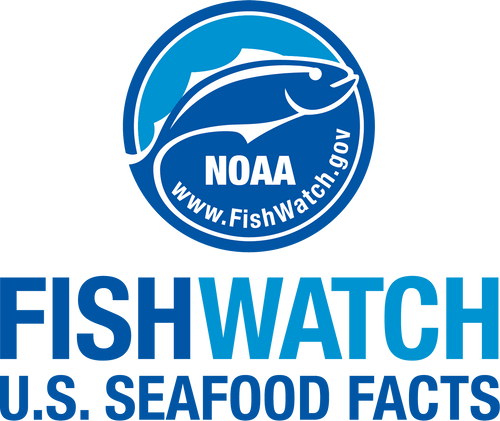About the Species
Yellowtail flounder live along the Atlantic coast of North America from Newfoundland to the Chesapeake Bay. There are three stocks in U.S waters: the Gulf of Maine/Cape Cod, Georges Bank, and Southern New England/Mid-Atlantic stocks, all of which NOAA Fisheries is working to rebuild.

Population
The Cape Cod/Gulf of Maine stock is not overfished. The Georges Bank and Southern New England/Mid-Atlantic stocks are overfished, but the fishing rate established under rebuilding plans promotes population growth.

Fishing Rate
The Cape Cod/Gulf of Maine and Southern New England/Mid-Atlantic stocks are not subject to overfishing. Overfishing status is unknown for the Georges Bank stock, but catch is at recommended level.

Habitat Impact
Area closures and gear restrictions protect habitats that are affected by some kinds of trawl gear.

Bycatch
Regulations are in place to minimize bycatch.
Population Status
There are three stocks of yellowtail flounder: Southern New England/Mid-Atlantic stock, Cape Cod/Gulf of Maine stock, and a Georges Bank stock. According to the most recent stock assessments:
- The Southern New England/Mid-Atlantic stock is overfished, but not subject to overfishing (2022 stock assessment). Summary stock assessment information can be found on Stock SMART.
- The Cape Cod/Gulf of Maine stock is not overfished, not subject to overfishing, and has rebuilt to the target population level (2022 stock assessment). Summary stock assessment information can be found on Stock SMART.
- The Georges Bank stock is overfished, but the overfishing status is unknown (2013 stock assessment). Summary stock assessment information can be found on Stock SMART.
Appearance
Yellowtail flounder is a thin-bodied, right-eyed flounder. They are wide—nearly half as broad as they are long—with an oval body. Their upper side, including the fins, is brownish or olive, tinged with red and marked with large, irregular rusty red spots. The underside is white, except for the caudal peduncle (the area between the body and the tail), which is yellowish. They have a small mouth and an arched lateral line. True to their name, their tail fin and the edges of the two long fins are yellow.
Biology
Yellowtail flounder grow faster than most flatfish, up to 22 inches and 2.2 pounds. They can live up to 17 years, although most don’t live past age 7. They also mature earlier than most flatfish.
Almost all females are able to reproduce by the time they reach age 3. They spawn during the spring and summer. Females spawn buoyant, spherical, pelagic eggs near the surface, along continental shelf waters of Georges Bank, northwest of Cape Cod, southern New England, and nearshore along New Jersey and southern Long Island. Eggs hatch approximately 5 days after fertilization at temperatures of 10–11° C.
When yellowtail flounder are first hatched, their eyes are symmetrical, with an eye on each side of their head. As the fish grows, it flattens out and the left eye slowly moves over to the right side of its head. After this metamorphosis, the juvenile settles to the ocean bottom.
Juvenile yellowtail flounder mostly eat worms. Adults feed on crustaceans and worms. Spiny dogfish, skate, and a number of fish such as cod, hakes, flounder, and monkfish prey on yellowtail flounder.
Where They Live
Range
Yellowtail flounder are found along the Atlantic coast of North America from Newfoundland to the Chesapeake Bay.
Habitat
Yellowtail flounder are relatively sedentary. They live on sandy bottoms in waters between 130 and 230 feet deep.
Fishery Management
There are three stocks of yellowtail flounder in U.S. waters, the Gulf of Maine/Cape Cod, Georges Bank, and Southern New England/Mid-Atlantic stocks.
NOAA Fisheries and the New England Fishery Management Council manage Gulf of Maine and Southern New England/Mid-Atlantic yellowtail flounder; NOAA Fisheries and the New England Fishery Management Council collaborate with Canada to jointly manage Georges Bank yellowtail flounder, because the stock spans the international boundary.
Yellowtail flounder, along with other groundfish in New England waters, are managed under the Northeast Multispecies Fishery Management Plan, which includes:
- Permitting requirements for commercial vessels
- Separate management measures for recreational vessels
- Time/Area Closures to protect spawning fish and habitat
- Minimum fish sizes to prevent harvest of juvenile fish
- Annual catch limits, based on best available science
- An optional sector (catch share) program can be used for yellowtail flounder and other groundfish species. The sector program allows fishermen to form harvesting cooperatives and work together to decide when, where, and how they harvest fish.
A rebuilding plan for the Gulf of Maine/Cape Cod stock was put in place in 2004 and the stock rebuilt in 2022. A rebuilding plan to rebuild the Southern New England/Mid-Atlantic stock to the target population level is in place with a target date of 2029. A rebuilding plan to rebuild the Georges Bank stock to the target population level is in place with a target date of 2032.
Harvest
Commercial Fishery for Yellowtail Flounder
In 2023, commercial landings of yellowtail flounder totaled 626,000 million pounds, and were valued at $439,000, according to the NOAA Fisheries commercial fishing landings database.
Gear Types, Habitat Impacts, and Bycatch
Yellowtail flounder are commonly harvested using trawl nets and, to a lesser extent, gillnets.
Areas closures and gear restrictions reduce habitat impacts from trawl nets. Fishermen follow management measures to designed to reduce interactions with marine mammals, including gear modifications, seasonal closures, and use of marine mammal deterrents.
Recreational Fishery for Yellowtail Flounder
Yellowtail flounder are not commonly encountered by the recreational fishery. Regulations include minimum fish sizes and possession limits.
Scientific Classification
| Kingdom | Animalia |
|---|---|
| Phylum | Chordata |
| Class | Actinopterygii |
| Order | Pleuronectiformes |
| Family | Pleuronectidae |
| Genus | Limanda |
| Species | ferruginea |
Last updated by NOAA Fisheries on 03/21/2025
Featured News
 Juvenile coho salmon. Credit: iStock
Juvenile coho salmon. Credit: iStock
NOAA Fisheries Releases 2023 Status of Stocks
 After each survey tow, the net is retrieved and the catch is emptied into a hopper where a series of conveyors move the catch to the sorting and processing area aboard the NOAA Ship Henry B. Bigelow. There, scientists sort the catch and collect data and biological samples. Credit: NOAA Fisheries/Jessica Blaylock
After each survey tow, the net is retrieved and the catch is emptied into a hopper where a series of conveyors move the catch to the sorting and processing area aboard the NOAA Ship Henry B. Bigelow. There, scientists sort the catch and collect data and biological samples. Credit: NOAA Fisheries/Jessica Blaylock
 Caption: Yellowtail flounder on a sandy bottom photographed by a towed sampling array called HabCam. Photo Courtesy Woods Hole Oceanographic Institution
Caption: Yellowtail flounder on a sandy bottom photographed by a towed sampling array called HabCam. Photo Courtesy Woods Hole Oceanographic Institution
Ocean Models Help Link Environmental Conditions to a Fishery Stock Assessment
 Winter flounder (Pseudopleuronectes americanus) in Narragansett Bay. It is a flatfish native to coastal waters of the western North Atlantic coast from Labrador to Georgia, although it is less common south of Delaware Bay. It feeds on bottom-dwelling animals. Photo: NOAA Fisheries
Winter flounder (Pseudopleuronectes americanus) in Narragansett Bay. It is a flatfish native to coastal waters of the western North Atlantic coast from Labrador to Georgia, although it is less common south of Delaware Bay. It feeds on bottom-dwelling animals. Photo: NOAA Fisheries
Predator-Prey Interaction Study Reveals More Food Does Not Always Mean More Consumption
Seafood Facts

Is Yellowtail Flounder Sustainable?
U.S. wild-caught yellowtail flounder is a smart seafood choice because it is sustainably managed and responsibly harvested under U.S. regulations.
Availability
Year-round.
Source
U.S. wild-caught from Maine to New Jersey.
Taste
Sweet and mild.
Texture
Lean, boneless, flaky, and firm.
Color
Raw flounder ranges in color from white to pinkish to tan. Cooked flounder is pure white.
Health Benefits
Flounder is a good low-fat source of B vitamins and niacin.
Nutrition Facts
Servings: 1; Serving Weight: 100 g (raw); Calories: 91; Protein: 18.84 g; Total Fat: 1.19 g; Total Saturated Fatty Acids: 0.283 g; Carbohydrate: 0 g; Total Sugars: 0 g; Total Dietary Fiber: 0 g; Cholesterol: 48 mg; Selenium: 32.7 mcg; Sodium: 81 mgMore Information
Flounder Recipes
Looking for some ways to add flounder into your rotation? If you need some cooking inspiration, browse these recipes for baked flounder with herbs, stuffed flounder, and more!

Last updated by NOAA Fisheries on 03/21/2025
Seafood News
 Fresh-caught taʻape on ice. Credit: Conservation International Hawaiʻi.
Fresh-caught taʻape on ice. Credit: Conservation International Hawaiʻi.
Reducing Waste and Feeding Communities in Hawaiʻi with a Whole Fish Approach
 Chef Tyler Hadfield’s Curried Skate Wings with Tomato-Masala Chutney
Chef Tyler Hadfield’s Curried Skate Wings with Tomato-Masala Chutney
Ring In the New Year With These Crowd-Favorite Seafood Recipes
 NOAA Fisheries, in collaboration with Blue Ocean Mariculture, is conducting a multi-year pilot study to evaluate observational methods and tools for studying Hawaiian monk seal behavior. Courtesy of Blue Ocean Mariculture
NOAA Fisheries, in collaboration with Blue Ocean Mariculture, is conducting a multi-year pilot study to evaluate observational methods and tools for studying Hawaiian monk seal behavior. Courtesy of Blue Ocean Mariculture
AI Meets Aquaculture to Study Hawaiian Monk Seal Interactions With Net Pens
 Tonya Wick aboard a fishing vessel at sea in 1998. Photo courtesy of Tonya Wick
Tonya Wick aboard a fishing vessel at sea in 1998. Photo courtesy of Tonya Wick
Management Overview
Yellowtail flounder is managed under the Northeast Multispecies (Groundfish) Fishery Management Plan along with 12 other species of groundfish. Collectively, these 13 species are referred to as the Northeast multispecies complex.
Learn more about the Northeast multispecies complex and its management
Last updated by NOAA Fisheries on 03/21/2025
Documents
Essential Fish Habitat Source Document For Yellowtail Flounder, Limanda ferruginea: Life History And Habitat Characteristics, 1999
Technical memo document about yellowtail flounder fish (Limanda ferruginea) life history and…
Data & Maps
Accuracy and Precision of Fish Ages - Northeast
It is important to ensure consistency in fish ages used in fish population assessments. The Fishery…
Research
Transboundary Resources Assessment Committee Documents
Peer-reviewed stock assessments performed by Transboundary Resources Assessment Committee, a…
Last updated by NOAA Fisheries on 03/21/2025





